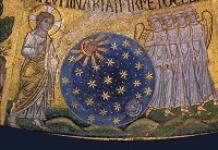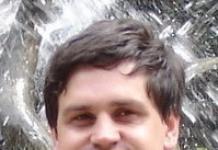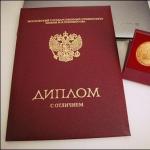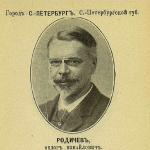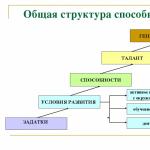Current page: 1 (book has 2 pages in total)
Vladimir Ivanovich Tikhonov
Fundamentals of the Divine world order of the Universe
© V. I. Tikhonov, 2018
© Publishing house "Aletheya" (St. Petersburg), 2018
1. Preface
For the first time in 1912, the American scientist W. Spider published his views “on the expansion” of the matter of the Universe. Then, based on the results of observations of distant galaxies and the determination of the “red” shift in the spectra, a conclusion was made about the “accelerated expansion” of the matter of the Universe. This conclusion served as the basis for the scientific hypothesis of the origin of the Universe as a result of the Big Bang. The “scientific” hypothesis about the origin of the material Universe is popularized by Western scientists. However, the evolutionary processes of all forms of matter, as well as the computer model of the “sicular spot” explosion, are not a convincing concept.
An analysis of the research of Russian scientists gives grounds to come to the concept of the stage-by-stage evolution of matter in the Universe.
With great respect I address the reader who seeks to understand the world around us. One of the difficult problems is the emergence of the world around us - the Universe.
Today it is difficult to navigate the large flow of publications of scientific discoveries. Scientific knowledge is always “fragmentary” and intuition is needed to understand its significance in the overall picture.
Consciousness, as a special substance, is capable of bringing together all the fragments of knowledge.
Scientific hypotheses that have existed for a long time and have supporters may be “untenable.” At the same time, contradictions accumulate and a new concept is formed from fragmentary knowledge.
So, despite numerous, expensive studies by supporters of the Big Bang, spacecraft in the Universe and the Large Hadron Collider (LHC) have not obtained any evidence of the concept of “relativistic” cosmology.
The modern concept of the origin and evolution of the Universe should be based on the latest achievements of the exact sciences: physics and astrophysics, as well as on the study of the evolution of all forms of matter, starting with field structures. It is also necessary to take into account the main factors influencing nature, such as information and psychological energy. It is necessary to remember M.V. Lomonosov, his fundamental principle: “The Creator gave the human race two books: The first is this visible world, the second is the Holy Scripture.”
Today it is worth returning to understanding the brief “fragmentary” picture of creation given by the prophet Moses in ancient centuries, when human consciousness could not understand many processes.
Human communication with the surrounding nature evokes a feeling of admiration for harmony. Harmony in the Universe could not arise by itself.
Even Rene Descartes, a great scientist, said: “there is God - the Creator of everything in the world, and since He exists and is the source of all truths, He did not create our mind by nature in such a way that the latter could be deceived in judgments and things perceived by it in the clearest and most distinct manner."
The book presents in a concise, popular form the main fundamental discoveries of the 20th century by Russian scientists, which are the basis for the concept of the origin and evolution of the Universe.
Main fundamental discoveries:
1. At the end of the 18th century, D.I. Mendeleev’s discovery of the “periodic law of chemical elements” and the creation on its basis of a periodic table of a system of chemical elements.
2. Even in the ancient philosophy of India, a description is given of the environment, which is the basis of everything and can become everything. This basis is real and very subtle and cannot be perceived. This subtle medium was called “akashi” (a modern synonym is ether or physical vacuum). Indian philosophy states that the entire universe arose from a physical vacuum under the influence of force.
The great scientist Nikola Tesla in 1907, in his work “The Greatest Achievement of Mankind,” wrote about the “primordial medium,” the luminiferous (ether), which fills everything and is the basis. True, the emergence of Einstein's theory of relativity took science in a different direction.
Only at the end of the 20th century did V.L. Dyatlov, using the works of scientists A.E. Akimov, Ya.P. Terletsky, G.I. Shipov, combine and make a fundamental discovery of the structure and special physical properties of the substance of the physical vacuum. The matter of physical vacuum is a substance that has unusual properties.
The complex structure of a particle of matter of physical vacuum - a quadriga particle - consists of two dipole elementary particles - antiparticles, which have physical properties: mass (weight). Polarity (charge), magnetic and spin moments. However, the total properties of the quadriga of physical vacuum are equal to zero. Under natural conditions, the PV substance is evenly distributed throughout space and in all objects of atomic matter: atoms, molecules, biological objects and participates with atomic matter, is invisible, and cannot be determined by instruments.
The PV substance has density and has the property of transmitting all types of energy: radiant energy (photons), invisible (neutrinos), gravity, electromagnetic at the speed of light (c) and subtle matter - information through torsion fields at a speed of 10 9 kilometers per second.
3. This fundamental discovery was made by scientists G.I. Shipov A.S. Akimov as a result of physical and mathematical calculations of the transfer of information, as the main control factor, in PV space in any direction at a speed of 10 9 per second, four orders of magnitude greater than the speed of light in torsion fields. Information not only spreads in the space of the Universe, but is also stored in a static state in field structures.
4. Fundamental discoveries include the appearance at the end of the 20th century of the New Cosmogonic Theory (NKT) by A.E. Khodkov and M.G. Vinogradova; the main provisions open the evolutionary process of transformation (synthesis) of atomic matter in the Universe.
1). The emergence of hydrogen from PV.
2). Special physical properties of hydrogen, which has the ability to deform. As a result, a thermoatomic reaction occurs - the formation of stars.
3). The discovery of the main function of stars is the transformation (synthesis) of all atomic matter in the Universe according to the laws of the Periodic Table of D. I. Mendeleev. The atomic formation of chemical elements of atomic matter occurs cyclically and sequentially. The evolution of a star ends after the synthesis of the seventh period of chemical atoms.
4). After the completion of the synthesis of atoms of one period and the accumulation of energy, a thermal shock explosion occurs and, together with the shell, the release of atomic matter. The ejected shell was collected in the planet Satellite of the star and acquired the properties of the mechanical energy of the star.
Historical studies of the evolution of the solar system have confirmed all these discoveries.
The linear process of evolution of education from simple to more complex, from fields - “nothing” to elementary particles (particles - antiparticles) of the physical vacuum, which is the material structure (the substance of all atomic matter and its various forms in the Universe. The process of evolution, as a constant process, goes according to the information plans of the Almighty, God is the Almighty of these information plans.
The “curtain” of history is closed to those who are idlely curious, but it is easily revealed to those who acquire Faith and who can know the Truth and discover for themselves the Great Mystery of the creation of the World.” Recent research by Russian scientists into the structure of the links of the material world has made it possible to draw up a modern model of the world order of the Universe. In this structure of the world order, the purpose and role of man and God - the Creator, the Creator - becomes clear. The work presents a brief and popular summary of the research and statements (thoughts) of Russian scientists.
M. V. Lomonosov proposed the formation of a system of knowledge based on two books given to us by God the Creator: “The first book is this visible world, created by Him. The second book is sacred scripture. In one book the Creator and Creator showed His Majesty, in another - His Will.”
D. I. Mendeleev writes: “I can’t, I just don’t have enough courage, to finish the presentation of my cherished thoughts without trying to convey my starting points. In my understanding, the frontier of science has barely been reached until now, and, apparently, will not serve long as the frontier of scientific knowledge. The line beyond which a non-scientific area begins, which must always come into contact with reality to come from it and return to it, this line comes down (again, again to avoid misunderstandings - in my opinion) to the acceptance of the original trinity of non-merging, combining with each other, eternal (as far as it is possible for us to recognize in reality) and that’s all 1
Added by the author.
Defining: substance (or matter), force (or energy) and spirit (or psychosis). The recognition of their fusion, origin and separation already lies outside the scientific field limited to reality or reality. It is only stated that in everything real one must recognize either matter, or force, or spirit, or, as is always the case, a combination of them, because in real manifestations neither matter without force, nor force (or movement) without substances, nor spirit without flesh or blood, without forces and matter."
L. I. Maslov, modern Russian scientist, academician, Doctor of Technical Sciences. – in the book “Revelations to the People of the New Century” and on the website www.otkroveniya.ru he presents fundamental knowledge on the world order and spirituality, as well as answers to many questions of modern times.
L.I. Maslov conveys a message to all people on the planet, just as in ancient centuries the prophet Moses (biblical), who was a contactee, and conveyed God’s message to people, the “ten commandments” fundamental to the coexistence of people, and a brief picture of the process of the emergence of the Universe.
“The lack of skills, the lack of knowledge is a dead end, there is a stop in the evolution of Consciousness, for the guiding star that illuminates a person’s path in the darkness of Space is only knowledge about the World, about the Creator and the canons of the Great Cosmos. All your delusions come from the desire to build the World on the basis of your own mind, building your own laws, ignoring the canons of Space.”
“But My revelations, given to you then (in the Ancient Ages) and now, remained and remain a subject of study only, unfortunately, for the inquisitive minds of rare units of humanity, but not for the majority engaged in the acquisition of material wealth.”
I need to convey to you people in a simple form the meaning of what is happening, of course, the meaning of what is to come, in order to prepare those who want to prepare and who, of course, believe what is happening.
I mean the fact of transferring the Knowledge of the Creator - My knowledge to people through a person, in the opinion of many of you, who does not have any right or Spiritual correspondence to do so.
“Energy exchange, Harmony and Love are the main conditions for the evolution of the Worlds and your form of existence in the dense world (I mean the biological form of life).”
N. A. Kozyrev, an outstanding Russian scientist, astrophysicist, discovered four-dimensional space. In fact, it has been proven by physical experiments. Four-dimensional space is filled with time - energy and is currently called Kozyrev space.
G. I. Shipov- a modern Russian scientist, claims that “there is a new level of physical reality, a symbol that in religion is God. I don’t know how this Deity works, but it really exists. It is impossible to know and study Him using our methods, and then science should not prove it, but only points to the existence of God.”
G.I. Shipov theoretically substantiated the concept of the existence of a physical vacuum as the main substance filling outer space, which is the basis for the transfer in space of all types of energy, as well as information. G.I. Shipov and A.E. Akimov, V.L. Dyatlov mathematically proved the transfer of information almost instantly in the space of the Universe.
A.E. Khodkov and M.G. Vinogradova at the end of the twentieth century developed a new cosmogonic theory. New principles of the birth of worlds and the evolution of the Solar system and the fundamental law of the process of atom formation. The fundamental discovery of the authors of the process of cosmogenesis, as a function of stars, the synthesis of atoms of matter and the formation of secondary celestial bodies - planets. The authors use the example of the historical evolution of the solar system to form our planet Earth. The solar system evolved for 1.8 billion years as a two-star system, with Jupiter and the Sun co-existing. Jupiter gave birth to planet Earth and after the end of evolution transferred leadership to the Sun. The new cosmogonic theory provides fundamental justification for the process of transformation (synthesis) of atomic matter in the Universe.
B. A. Dyatlov, Russian scientist, using the work on the study of physical vacuum (PV) by Ya. P. Terletsky and G. I. Shipov, A. E. Akimova, developed a model of PV and found the relationship and conditions for the existence of elementary particles in the medium (substance) and cellular structure particles with physical properties: polarity, mass, magnetic moment and spin. The PV model is an elementary cell, which consists of a pair (dipole) of particles: particle – antiparticle. This model is called quadriga.
The space of the Universe is uniformly filled with the PV substance. Substance is a medium in which all types of energy propagate: light (photons), neutrinos, torsion fields through which information propagates and all types of fields: magnetic, electromagnetic and particle mass fields.
S. A. Kirpichnikov, scientist, Ph.D. n. developed a model of an integral system of the world order of the Universe.
V.P. Kaznacheev, scientist, academician, states: “Man, the highest link in the evolution of the biosphere, was once prepared, both physiologically and evolutionarily, subjected to the massive introduction of “life-bearing” ether into him.”
Jesus Christ says: “Do not look for the law in your books and writings, for the law is life, but the scriptures are dead. I tell you the truth, Moses received these laws from God not in written form, but through the living word. The Law is the living word of the living God, given to the living prophets for the living people. This law is written in everything that is life. You can find it in the grass, in the trees, in the rivers, in the mountains, in the birds of the air, in the fish of the sea, but above all, look for it in yourself. For truly I say to you, every living thing is closer to God than the scriptures in which there is no life. God created life and all living beings in such a way that they could learn the laws of the true God through the eternal word. God wrote these laws not on the pages of books, but in your hearts and in your soul. They are in your breath, in your blood, in your bones, in your flesh, in your insides, your eyes, in your ears and in every smallest particle of your bodies.”
2. Introduction
“I believe in one God, the Father, Almighty, Creator/Maker of heaven and earth, visible to all and invisible to all.”
Symbol of faith
2.1. Uniformity and consistency of the material Universe. Features of ultra-small discrete-wave quanta and influence on the consistency of the physical properties of the space of the Universe
Vacuum in physics has a certain concept - complete emptiness in space. In cosmological science it means the absence of any matter in outer space. In the 19th century, physicists discovered invisible fields in outer space and called them “ether.” In cosmological science, invisible fields and all particles in outer space began to be called physical vacuum. After the discovery of unusual ultra-small quanta, which are, at the same time, discrete-wave energy particles - quantum vacuum. Quantum vacuum (KB) and physical vacuum (PV) are evenly distributed in the outer space of the Universe and constantly coexist with particles of atomic matter (AM).
As a substance, physical vacuum has the property of vibration and density, and also has the ability to transmit all types of energy: light (photons), electromagnetic, gravitational and information (subtle matter).
One of the important discoveries of physicists in the 20th century was the discovery of the pattern of non-local “consistency” of outer space in the Universe. Space exploration at various points in space using more than thirty physical parameters confirms their consistency.
Today there is enough reason to believe that the regulation of nonlocal coherence in outer space is due to the influence of special quantum particles. It was revealed during experiments that ultra-small particles can manifest themselves as a discrete particle with mass, and as wave energy - light or as a force. At the same time, bound by energy fields, some quanta may have the physical properties of matter, others may have electromagnetic, wave or light properties. But quanta have the property that, having once been in the same conditions with each other, they remain forever interconnected over large distances.
They remain interconnected at very large distances from each other, having been in the system with each other and having received real properties, they will confirm them, that is, they will show non-local consistency. Experiments have confirmed that quanta located at large distances from each other communicate at a speed exceeding the speed of light (c) by four orders of magnitude - 2 · 10 9 km/sec. Ultra-small quanta can be combined into superstrings (threads) that constantly vibrate. These superstrings, coexisting with particles of atomic matter and physical objects, receiving information, vibrate only at their specific frequency (actave), transmitting it in the form of wave energy. At the cosmic level, this phenomenon has long been known. All objects in Space: stars, planets, galaxies have their own octave (frequency). This physical phenomenon determines and informs about the state of change of a physical object in the Universe.
Long-term searches for the beginning of the process of evolution of matter, during the development of the theory of quantum and interaction with energy fields, revealed the possibility of transformation (production) of more complex particles and antiparticles - physical vacuum. When a PV particle is localized, a spatial mismatch (hole) is created, which leads to the formation of an antiparticle.
Under the condition of antipodality, they are localized without annihilation, due to the lack of complete specularity of particles (structure).
The discovery and study of discrete wave quanta has revealed their incredible behavior in the real visible world. With a quantum there is a continuous dance of virtual and real states, that is, a mysterious interaction of real and virtual states and is complemented by a connection with space and time of particles.
Strange behavior of quanta
1. In the initial state, quanta are not located in a single place in time, each quantum is simultaneously “here” and “there” - and in a sense, in space time it is present everywhere.
2. Until quanta are observed and measured, they do not have specific characteristics; they exist in several states at the same time. These states are not real, but virtual - quanta are capable of accept, When their observe or measure. Observer or measuring device like as if they were catching a quantum from a sea of possibilities. When the quantum left sea, it becomes real and not just virtual, but we never Not we can know in advance what kind of beast of all possible he will become. Perhaps a quantum can independently choose its real state among the virtual ones.
3. Even when a quantum is in a real state, it does not allow us to observe and measure all parameters of its state at the same time: when we measure one parameter (for example, position or energy), others become unclear (such as speed of movement or observation time).
4. Quanta are very social: if they were in the same state, they remain connected to each other, regardless of how far they are from each other. When one quantum from a pair of interconnected ones is observed or measured, it selects own state, but not free: he chooses it in accordance with the choice of the first. The second one always chooses the additional state and never the state chosen by the first one.
5. In a complex system (such as the situation of a physical experiment), quanta exhibit the same social behavior. If we measure one quantum in the system, others will also move from a virtual state to a real one. Moreover, if we create an experimental situation in which a certain quantum can be measured individually, all other quanta become real, even if the experiment is not performed.
Some main conclusions from observations of processes in the Universe:
1. There is no “empty” space without energy in the Universe. In the absence of particles (matter), space cannot be “pure”, that is, there is no pure vacuum. In a vacuum, there are various field structures with positive energy.
2. The main property of the Universe is uniformity and non-local consistency. According to all basic physical and other parameters, there is complete harmony in the Universe, which, for now, cannot be explained.
Divine foundations of the structure of the world order of the Universe Vladimir Tikhonov
(No ratings yet)
 Title: Divine foundations of the structure of the world order of the Universe
Title: Divine foundations of the structure of the world order of the Universe
About the book by Vladimir Tikhonov “The Divine Foundations of the Structure of the World Order of the Universe”
Today it is difficult to navigate the large flow of publications of scientific discoveries. Scientific knowledge is always “fragmentary” and intuition is needed to understand its significance in the overall picture. Consciousness, as a special substance, is capable of bringing together all the fragments of knowledge. The book presents in a concise, popular form the main fundamental discoveries of the 20th century by Russian scientists, which are the basis for the concept of the origin and evolution of the Universe.
On our website about books, you can download the site for free without registration or read online the book “The Divine Foundations of the Structure of the World Order of the Universe” by Vladimir Tikhonov in epub, fb2, txt, rtf, pdf formats for iPad, iPhone, Android and Kindle. The book will give you a lot of pleasant moments and real pleasure from reading. You can buy the full version from our partner. Also, here you will find the latest news from the literary world, learn the biography of your favorite authors. For beginning writers, there is a separate section with useful tips and tricks, interesting articles, thanks to which you yourself can try your hand at literary crafts.
Scientific picture of the world- many scientific theories collectively describing the world known to man, an integral system of ideas about the general principles and laws of the structure of the universe.
Definitions
Scientific picture of the world- one of the fundamental concepts in the philosophy of science - a special form of systematization of knowledge, qualitative generalization and ideological synthesis of various scientific theories. Being an integral system of ideas about the general properties and patterns of the world, the scientific picture of the world exists as a complex structure, including as components the general scientific picture of the world and the world picture of individual sciences. Pictures of the world of individual sciences, in turn, include corresponding numerous concepts - certain ways of understanding and interpreting any objects, phenomena and processes of the objective world that exist in each individual science.
A belief system that affirms the fundamental role of science as a source of knowledge and judgment about the world is called scientism.
In the process of learning about the world around us, knowledge, abilities, skills, types of behavior and communication are reflected and consolidated in the human mind. The totality of the results of human cognitive activity forms a certain model (picture of the world). In the history of mankind, a fairly large number of very diverse pictures of the world were created and existed, each of which was distinguished by its vision of the world and its specific explanation. However, the progress of ideas about the world around us is achieved mainly through scientific research. The scientific picture of the world does not include private knowledge about the various properties of specific phenomena, or about the details of the cognitive process itself. The scientific picture of the world is not the totality of all human knowledge about the objective world; it represents an integral system of ideas about the general properties, spheres, levels and patterns of reality.
The picture of the world is a systemic formation, therefore its change cannot be reduced to any single (even the largest and most radical) discovery. We are usually talking about a whole series of interrelated discoveries (in the main fundamental sciences), which are almost always accompanied by a radical restructuring of the research method, as well as significant changes in the very norms and ideals of science.
Scientific picture of the world- a special form of theoretical knowledge that represents the subject of scientific research in accordance with a certain stage of its historical development, through which specific knowledge obtained in various fields of scientific research is integrated and systematized.
For Western philosophy in the mid-90s of the 20th century, there were attempts to introduce new categorical means into the arsenal of methodological analysis, but at the same time, a clear distinction between the concepts of “picture of the world” and “scientific picture of the world” was not made. In our domestic philosophical and methodological literature, the term “picture of the world” is used not only to denote a worldview, but also in a narrower sense - when it comes to scientific ontologies, that is, those ideas about the world that are a special type of scientific theoretical knowledge. In this meaning scientific picture of the world acts as a specific form of systematization of scientific knowledge that sets a vision of the objective world of science in accordance with a certain stage of its functioning and development .
The phrase can also be used natural science picture of the world .
In the process of development of science, there is a constant renewal of knowledge, ideas and concepts, earlier ideas become special cases of new theories. The scientific picture of the world is not a dogma and not an absolute truth. Scientific ideas about the world around us are based on the totality of proven facts and established cause-and-effect relationships, which allows us to make conclusions and predictions about the properties of our world that contribute to the development of human civilization with a certain degree of confidence. The discrepancy between the test results of a theory, hypothesis, concept, and the identification of new facts - all this forces us to reconsider existing ideas and create new ones that are more consistent with reality. This development is the essence of the scientific method.
- ideological structures that lie at the foundation of the culture of a certain historical era. The terms are used in the same meaning image of the world, world model, vision of the world, characterizing the integrity of the worldview.
- scientific ontologies, that is, those ideas about the world that are a special type of scientific theoretical knowledge. In this sense, the concept of a scientific picture of the world is used to mean:
- horizon of systematization of knowledge obtained in various scientific disciplines. The scientific picture of the world acts as a holistic image of the world, including ideas about nature and society
- systems of ideas about nature that develop as a result of the synthesis of natural science knowledge (in a similar way, this concept denotes the body of knowledge obtained in the humanities and social sciences)
- through this concept, a vision of the subject of a particular science is formed, which takes shape at the corresponding stage of its history and changes during the transition from one stage to another.
According to the indicated meanings, the concept of a scientific picture of the world is split into a number of interrelated concepts, each of which means a special type of scientific picture of the world How special level of systematization of scientific knowledge :
- general scientific picture of the world (systematized knowledge obtained in various fields)
- natural-scientific picture of the world and social (social)-scientific picture of the world
- concrete scientific picture of the world (physical picture of the world, picture of the reality under study)
- a special (private, local) scientific picture of the world of individual branches of science.
They also highlight a “naive” picture of the world
The scientific picture of the world is neither philosophy nor science; The scientific picture of the world differs from scientific theory in the philosophical transformation of the categories of science into fundamental concepts and the absence of the process of obtaining and arguing knowledge; Moreover, the scientific picture of the world is not reduced to philosophical principles, since it is a consequence of the development of scientific knowledge.
Historical types
There are three clearly and unambiguously fixed radical changes in the scientific picture of the world, scientific revolutions in the history of the development of science, which are usually personified by the names of the three scientists who played the largest role in the changes that took place.
Aristotelian
Period: VI-IV centuries BC
Conditioning:
Reflection in works:
- Most fully - Aristotle: the creation of formal logic (the doctrine of evidence, the main tool for deducing and systematizing knowledge, developed a categorical-conceptual apparatus), approval of a unique canon for the organization of scientific research (history of the issue, statement of the problem, arguments for and against, justification for the decision), differentiation knowledge itself (separation of natural science from mathematics and metaphysics)
Result:
- the emergence of science itself
- separation of science from other forms of knowledge and exploration of the world
- creation of certain norms and samples of scientific knowledge.
Newtonian scientific revolution
Period: XVI-XVIII centuries
Starting point: transition from a geocentric model of the world to a heliocentric one.
Conditioning:
Reflection in works:
- Discoveries: N. Copernicus, G. Galileo, I. Kepler, R. Descartes. I. Newton summed up their research and formulated the basic principles of a new scientific picture of the world in general terms.
Main changes:
- The language of mathematics, the identification of strictly objective quantitative characteristics of earthly bodies (shape, size, mass, movement), their expression in strict mathematical laws
- Methods of experimental research. The phenomena under study are under strictly controlled conditions
- Refusal of the concept of a harmonious, complete, purposefully organized cosmos.
- Concepts: The Universe is infinite and united only by the action of identical laws
- Dominant: mechanics, all considerations based on the concepts of value, perfection, goal setting were excluded from the scope of scientific research.
- Cognitive activity: a clear opposition between the subject and object of research.
Result: the emergence of a mechanistic scientific picture of the world on the basis of experimental mathematical natural science.
Einstein's revolution
Period: turn of the XIX-XX centuries.
Conditioning:
- Discoveries:
- complex atomic structure
- radioactivity phenomenon
- discrete nature of electromagnetic radiation
- and etc.
The result: the most important premise of the mechanistic picture of the world was undermined - the conviction that with the help of simple forces acting between unchanging objects, all natural phenomena can be explained.
Criticism and comparison with other “pictures of the world”
The very concept of “picture of the world” is not self-evident. Martin Heidegger points out that such a term is characteristic only of modern European culture; neither antiquity nor the Middle Ages knew it. The world, understood as a picture, is possible only when a person becomes the “first and exclusive subject”, makes himself a point of reference for existence as such. The scientific picture of the world is one of the possible pictures of the world, therefore it has something in common with all other pictures of the world - mythological, religious, philosophical - and something special that distinguishes the scientific picture of the world from the diversity of all other images of the world Doctor philosophy Pavel Chelyshev believes that the scientific picture of the world is not complete and not final, science provides only “facts” that can be explained from different ideological positions. To search for ideological foundations, one must turn to philosophy, religion, art, and everyday consciousness.
With religious
The scientific picture of the world may differ from religious ideas about the world, based on the authority of the prophets, religious tradition, sacred texts, etc. Therefore, religious ideas are more conservative, unlike scientific ones, which change as a result of the discovery of new facts. In turn, religious concepts of the universe can change in order to get closer to the scientific views of their time. The basis for obtaining a scientific picture of the world is an experiment that allows you to confirm the reliability of certain judgments. The basis of the religious picture of the world is faith into the truth of certain judgments belonging to some authority. However, as a result of experiencing all sorts of “esoteric” states (not only of religious or occult origin), a person can gain personal experience that confirms a certain picture of the world, but in most cases, attempts to build a scientific picture of the world on this relate to pseudoscience.
From artistic and everyday life
The scientific picture of the world also differs from the worldview characteristic of the everyday or artistic perception of the world, which uses everyday/artistic language to designate objects and phenomena of the world. For example, a person of art creates artistic images of the world based on the synthesis of his subjective (emotional perception) and objective (dispassionate) comprehension, while a person of science is focused exclusively on the objective and, with the help of critical thinking, eliminates subjectivity from the results of research.
Philosophically
Universe
History of the Universe
Birth of the Universe
At the moment of the Big Bang, the Universe and space itself had microscopic, quantum dimensions.
Some physicists admit the possibility of a multiplicity of similar processes, and therefore a multiplicity of universes with different properties. The fact that our Universe is adapted for the formation of life can be explained by chance - in “less adapted” universes there is simply no one to analyze this (see the Anthropic principle and the text of the lecture “Inflation, quantum cosmology and the anthropic principle”). A number of scientists have put forward the concept of a “boiling Multiverse”, in which new universes are continuously born and this process has no beginning or end.
It should be noted that the fact of the Big Bang itself is with a high degree of probability proven, but explanations of its causes and detailed descriptions of how it happened are still classified as hypotheses.
Evolution of the Universe
The expansion and cooling of the Universe in the first moments of the existence of our world led to the next phase transition - the formation of physical forces and elementary particles in their modern form.
The dominant hypotheses are that for the first 300-400 thousand years the Universe was filled only with ionized hydrogen and helium. As the Universe expanded and cooled, they transitioned to a stable neutral state, forming ordinary gas. Presumably, after 500 million years, the first stars lit up, and clumps of matter formed in the early stages due to quantum fluctuations turned into galaxies.
As research in recent years has shown, planetary systems around stars are very common (at least in our Galaxy). There are several hundred billion stars in the Galaxy and, apparently, no less number of planets.
Based on Einstein's theory, Herman Minkowski created an elegant theory describing space and time as 4-dimensional spacetime (Minkowski space). In space-time, distances (more precisely, hyperdistances, since they include time as one of the coordinates) are absolute: they are the same for any observer.
Having created the special theory of relativity, Einstein generalized it into the general theory of relativity, including gravity. According to the general theory of relativity, massive bodies bend space-time, which causes gravitational interactions. At the same time, the nature of gravity and acceleration is the same - we can feel acceleration or gravity if we make a curvilinear movement in space-time.
Modern physics is faced with the task of creating a general theory that unites quantum field theory and the theory of relativity. This would explain the processes occurring in black holes and, possibly, the Big Bang mechanism.
According to Newton, empty space is a real entity (this statement is illustrated by a thought experiment: if in an empty Universe we spin a plate of sand, the sand will begin to fly apart, as the plate will spin relative to empty space). According to the Leibniz-Mach interpretation, only material objects are real entities. It follows from this that the sand will not fly apart, since its position relative to the plate does not change (that is, nothing happens in the reference frame rotating with the plate). In this case, the contradiction with experience is explained by the fact that in reality the Universe is not empty, but the entire set of material objects forms a gravitational field, relative to which the plate rotates. Einstein initially believed that the Leibniz-Mach interpretation was correct, but in the second half of his life he was inclined to believe that space-time is a real entity.
According to experimental data, the (ordinary) space of our Universe at large distances has zero or very small positive curvature. This is explained by the rapid expansion of the Universe at the initial moment, as a result of which the elements of the curvature of space were leveled out (see Inflationary model of the Universe).
In our Universe, space has three dimensions (according to some theories, there are additional dimensions at microdistances), and time has one.
Time moves in only one direction (the "arrow of time"), although physical formulas are symmetrical with respect to the direction of time, with the exception of thermodynamics. One explanation for the unidirectionality of time is based on the second law of thermodynamics, according to which entropy can only increase and therefore determines the directionality of time. The increase in entropy is explained by probabilistic reasons: at the level of interaction of elementary particles, all physical processes are reversible, but the probability of a chain of events in the “forward” and “reverse” directions may be different. Thanks to this probabilistic difference, we can judge past events with greater confidence and certainty than future events. According to another hypothesis, the reduction of the wave function is irreversible and therefore determines the direction of time (however, many physicists doubt that reduction is a real physical process). Some scientists are trying to reconcile both approaches within the framework of decoherence theory: during decoherence, information about most previous quantum states is lost, therefore, this process is irreversible in time.
Physical vacuum
According to some theories, vacuum can exist in different states with different energy levels. According to one hypothesis, the vacuum is filled with the Higgs field (the “remnants” of the inflaton field preserved after the Big Bang), which is responsible for the manifestations of gravity and the presence of dark energy.
Some of these field theory predictions have already been successfully confirmed by experiment. Thus, the Casimir effect and the Lamb shift of atomic levels are explained by zero-point oscillations of the electromagnetic field in the physical vacuum. Modern physical theories are based on some other ideas about vacuum. For example, the existence of multiple vacuum states (the false vacua mentioned above) is one of the main foundations of the Big Bang inflationary theory.
Elementary particles
All elementary particles are characterized by wave-particle dualism: on the one hand, particles are single indivisible objects, on the other hand, the probability of detecting them is “smeared” across space (“smearing” is of a fundamental nature and is not just a mathematical abstraction, this fact is illustrated by for example, an experiment with the simultaneous passage of a photon through two slits at once). Under some conditions, such “smearing” can even take on macroscopic dimensions.
Quantum mechanics describes a particle using the so-called wave function, the physical meaning of which is still unclear. The square of its modulus determines not where exactly the particle is, but where it could be and with what probability. Thus, the behavior of particles is fundamentally probabilistic in nature: due to the “smearedness” of the probability of detecting a particle in space, we cannot determine its location and momentum with absolute certainty (see the uncertainty principle). But in the macrocosm, dualism is insignificant.
When experimentally determining the exact location of a particle, the wave function is reduced, that is, during the measurement process, a “smeared” particle turns at the time of measurement into a “non-smeared” one with one of the interaction parameters randomly distributed, this process is also called the “collapse” of the particle. Reduction is an instantaneous process (implemented above the speed of light), so many physicists consider it not a real process, but a mathematical method of description. A similar mechanism operates in experiments with entangled particles (see quantum entanglement). At the same time, experimental data allow many scientists to assert that these instantaneous processes (including the relationship between spatially separated entangled particles) are of a real nature. In this case, information is not transmitted and the theory of relativity is not violated.
The reasons why there is precisely such a set of particles, the reasons for the presence of mass in some of them and a number of other parameters are still unknown. Physics is faced with the task of constructing a theory in which the properties of particles would follow from the properties of the vacuum.
One of the attempts to build a universal theory was string theory, in which fundamental elementary particles are one-dimensional objects (strings), differing only in their geometry.
Interactions
Many theoretical physicists believe that in reality there is only one interaction in nature, which can manifest itself in four forms (just as the whole variety of chemical reactions are different manifestations of the same quantum effects). Therefore, the task of fundamental physics is to develop a theory of “grand unification” of interactions. To date, only the theory of electroweak interaction has been developed, which combines weak and electromagnetic interactions.
It is assumed that at the moment of the Big Bang there was a single interaction, which was divided into four in the first moments of the existence of our world.
Atoms
The matter that we encounter in everyday life is made up of atoms. Atoms include an atomic nucleus, consisting of protons and neutrons, as well as electrons that “flicker” around the nucleus (quantum mechanics uses the concept of “electron cloud”). Protons and neutrons are classified as hadrons (which are made up of quarks). It should be noted that in laboratory conditions it was possible to obtain “exotic atoms”, consisting of other elementary particles (for example, pionium and muonium, which include pion and muon.).
Life
Concept of living
According to the definition of Academician of the Russian Academy of Sciences E.M. Galimov, life is a phenomenon of increasing and inherited ordering materialized in organisms, inherent under certain conditions of the evolution of carbon compounds. All living organisms are characterized by isolation from the environment, the ability to self-reproduce, functioning through the exchange of matter and energy with the environment, the ability to vary and adapt, the ability to perceive signals and the ability to respond to them.
The structure of living organisms, genes and DNA
Evolution of living organisms
Principles of evolution
The development of life on Earth, including the complication of living organisms, occurs as a result of unpredictable mutations and subsequent natural selection of the most successful of them.
The development of such complex devices as the eye as a result of "random" changes may seem incredible. However, analysis of primitive biological species and paleontological data shows that the evolution of even the most complex organs occurred through a chain of small changes, each of which individually does not represent anything unusual. Computer modeling of the development of the eye led to the conclusion that its evolution could be carried out even faster than it happened in reality
In general, evolution, change in systems, is a fundamental property of nature, reproduced in laboratory conditions. For open systems this does not contradict the law of increasing entropy. The science of synergetics studies processes of spontaneous complication. One example of the evolution of nonliving systems is the formation of dozens of atoms based on only three particles and the formation of billions of complex chemical substances based on atoms.
History of life on Earth
According to paleontological data, the first prokaryotes (bacteria) appeared about 4 billion years ago. The first eukaryotes (cells with a nucleus) formed approximately 2 billion years ago as a result, according to one of the most common theories, of prokaryotic symbiosis. The first multicellular organisms appeared about 1 billion years ago as a result of the symbiosis of eukaryotes. About 600 million years ago, many animals familiar to us appeared (for example, fish, arthropods, etc.). 400 million years ago life came to land. 300 million years ago trees (with hard fibers) and reptiles appeared, 200 million years ago -
World order
Whole Knowledge, the Righteous Ones report that the World (Metaverse, Genesis) is a Trinity and everything in the World, as a World Building, a building of worlds, consists of trinities and is trinities. Therefore, in the first language, to create, to create, will be s-Troit - based on the Trinity.
The Trinity is a universal concept that unites the form and content of every co-existence of the eternal and infinite World. For example, in relation to Numbers, the Trinity is Three, and here three-dimensionality, volume, and friction are the universal principle of relationships.
A necessary and sufficient condition for the emergence of life, the Trinity in external form is an ideal Sphere. Turning to science, we can recall that the mathematician W. Thursten theoretically substantiated the sphericity of the Metaverse, for which he was recognized by his colleagues as the “god of topology,” and our famous G. Perelman proved this.
Why don't we see natural ideal forms in nature? Because our human, “anthropologically dependent” universe, as part of the Metaverse, is limited and finite. Being limiting and definite, it is imperfect, but its basis, the boundless and indefinite Trinity, the world's All-Nothing, is impeccable, true and ideal.
In its content, the Trinity is a single conscious mass with the properties of energy-information, located beyond the limits of any particular space-time continuum, any separate world. As a transcendental, complete noumenon, the world mass (Knowledge at rest, Consciousness in motion) controls all external – ultimate – processes. Different volumes of time and subordinate space transferred within the limits of measures define an incredible variety of world manifestations and create the illusion of independence of the particular from the general.
In form and content, every atom, every star and every world is a trinity. Proof of this can be, for example, the Big Bang theory accepted by science, according to which our universe instantly turned from a point into a spherical volume. And for now it is expanding in all directions, but then it will collapse, again turn into a point and disappear in the boundless world environment.
In the center of the world Sphere, and therefore of any particular Trinity, there is a world Point - a focus that has concentrated in itself all the potential for the development of the world. Moreover, the Point that appears first in any ultimate and limited space-time continuum will actually be a Focus, a Hole from the unlimited Beyond, the place of existence of the conscious immortal mass.
The connection between the Hole-Point and the Sphere of the Trinity occurs through the Ray, it is also called the World Axis.
Thus, the general structure of the universal, absolutely simple and absolutely complex World is basically this. This is a Trinity, in form - a Hole-Point in the center, a Sphere on the periphery, the intermediary between them is the Ray, intermittent, dual, consisting of holes and points. According to the Beam, which has the characteristics of both a hole (sphere) and a point, there is an instantaneous (out of time, since beyond the limit of time) transfer of information-energy. Despite the fact that every trinity itself consists of an infinite number of its “corporeal” trinities, the same infinite number of rays connecting the center and periphery of the world provides absolute information content, giving rise to the Star (Astra) of the World.
In the Trinity, as the Being of the conscious mass, the Point in the center is the Lord, the Essence, the Purpose. The sphere on the periphery is God, one time. The Ray between the Point and the Sphere is the Devil, dual space, capable of separation, division.
In order to ensure world balance and preserve energy, which is not available within, the Trinity has its own Shadow - the Paratrinity. The Prince of the Paratrinity is Satan, opposite to the Lord. The relationship between the Lord and Satan generated by the Lord is the world Game, CHIN and NOTHING.
World order
Scientific picture of the world(NKM) - (one of the fundamental concepts in natural science) a special form of systematization of knowledge, qualitative generalization and ideological synthesis of various scientific theories. Being an integral system of ideas about the general properties and patterns of the objective world, the scientific picture of the world exists as a complex structure, including as components the general scientific picture of the world and the picture of the world of individual sciences (physical, biological, geological, etc.). Pictures of the world of individual sciences, in turn, include corresponding numerous concepts - certain ways of understanding and interpreting any objects, phenomena and processes of the objective world that exist in each individual science.
In the process of learning about the world around us, the results of knowledge are reflected and consolidated in the human mind in the form of knowledge, abilities, skills, types of behavior and communication. The totality of the results of human cognitive activity forms a certain model (picture of the world). In the history of mankind, a fairly large number of very diverse pictures of the world were created and existed, each of which was distinguished by its vision of the world and its specific explanation. However, the broadest and most complete picture of the world is provided by the scientific picture of the world, which includes the most important achievements of science that create a certain understanding of the world and man’s place in it. It does not include private knowledge about the various properties of specific phenomena, or about the details of the cognitive process itself. The scientific picture of the world is not the totality of all human knowledge about the objective world; it represents an integral system of ideas about the general properties, spheres, levels and patterns of reality.
Scientific picture of the world- a system of human ideas about the properties and patterns of reality (the really existing world), built as a result of generalization and synthesis of scientific concepts and principles. Uses scientific language to refer to objects and phenomena of matter.
In the process of development of science, there is a constant renewal of knowledge, ideas and concepts, earlier ideas become special cases of new theories. The scientific picture of the world is not a dogma and not an absolute truth. Scientific ideas about the world around us are based on the totality of proven facts and established cause-and-effect relationships, which allows us to make conclusions and predictions about the properties of our world that contribute to the development of human civilization with a certain degree of confidence. The discrepancy between the test results of a theory, hypothesis, concept, and the identification of new facts - all this forces us to reconsider existing ideas and create new ones that are more consistent with reality. This development is the essence of the scientific method.
Comparison with other views
With religious
The scientific picture of the world may differ from religious ideas about the world, based on the authority of the prophets, religious tradition, sacred texts, etc. Therefore, religious ideas are more conservative in contrast to scientific ones, which change as a result of the discovery of new facts. In turn, religious concepts of the universe can change in order to get closer to the scientific views of their time. The basis for obtaining a scientific picture of the world is an experiment that allows you to confirm the reliability of certain judgments. The basis of the religious picture of the world is the acceptance on faith of certain judgments belonging to some authority.
With artistic and everyday
The scientific picture of the world also differs from the worldview characteristic of the everyday or artistic perception of the world, which uses everyday/artistic language to designate objects and phenomena of the world. For example, a person of art creates artistic images of the world based on the synthesis of his subjective (emotional perception) and objective (dispassionate) comprehension, while a person of science is focused exclusively on the objective and, with the help of critical thinking, eliminates subjectivity from the results of research. Emotional perception is right-hemisphere (figurative), while logical scientific justification, abstractions, and generalizations are left-hemisphere.
With philosophical
The relationship between science and philosophy is a subject of debate. On the one hand, the history of philosophy is a humanities science, the main method of which is the interpretation and comparison of texts. On the other hand, philosophy claims to be something more than science, its beginning and result, the methodology of science and its generalization, a theory of a higher order, metascience. Science exists as a process of putting forward and refuting hypotheses; the role of philosophy in this case is to study the criteria of scientificity and rationality. At the same time, philosophy comprehends scientific discoveries, including them in the context of formed knowledge and thereby determining their meaning. Connected with this is the ancient idea of philosophy as the queen of sciences or the science of sciences.
With mixed
All of the above ideas can be present in a person individually, all together and in various combinations. The scientific picture of the world, although it can constitute a significant part of the worldview, is never an adequate replacement for it, because in his individual existence, a person needs both emotions and artistic or purely everyday perception of the surrounding reality, and ideas about what is beyond the limits of what is reliably known or on the border of the unknown, which must be overcome at one point or another in the process of cognition.
Evolution of ideas
There are different opinions about how ideas about the world change in human history. Because science is relatively new, it can provide additional information about the world. However, some philosophers believe that over time the scientific picture of the world should completely supplant all others.
Universe
History of the Universe
Birth of the Universe
At the moment of the Big Bang, the Universe occupied microscopic, quantum dimensions.
Some physicists admit the possibility of a multiplicity of similar processes, and therefore a multiplicity of universes with different properties. The fact that our Universe is adapted for the formation of life can be explained by chance - in “less adapted” universes there is simply no one to analyze this (see the Anthropic principle and the text of the lecture “Inflation, quantum cosmology and the anthropic principle”). A number of scientists have put forward the concept of a “boiling Multiverse”, in which new universes are continuously born and this process has no beginning or end.
It should be noted that the fact of the Big Bang itself can with a high degree of probability be considered proven, but explanations of its causes and detailed descriptions of how it happened are still classified as hypotheses.
Evolution of the Universe
The expansion and cooling of the Universe in the first seconds of the existence of our world led to the next phase transition - the formation of physical forces and elementary particles in their modern form.
The dominant hypotheses are that for the first 300-400 thousand years the Universe was filled only with ionized hydrogen and helium. As the Universe expanded and cooled, they transitioned to a stable neutral state, forming ordinary gas. Presumably in 500 million years. The first stars were lit, and clumps of matter formed in the early stages due to quantum fluctuations turned into galaxies.
Formation of planetary systems
The formation of stars and planetary systems is studied by the science of cosmogony. Under the influence of gravity, condensations are formed in gas and dust clouds with the formation of rotating gas and dust disks. The bulk of the matter is concentrated in the center of the disk, where the temperature rises, as a result of which a thermonuclear reaction begins and a star flares up (star births in gas and dust clouds have been observed through a telescope). Planets form in the remaining parts of the disk.
As research in recent years has shown, planetary systems around stars are very common (at least in our Galaxy). There are several hundred billion stars in the Galaxy and, apparently, no less number of planets.
The structure of the Universe
One of the most important properties of the Universe is that it is expanding, and at an accelerated rate. The farther an object is from our galaxy, the faster it is moving away from us (but this does not mean that we are in the center of the world: the same is true for any point in space).
Visible matter in the Universe is structured into star clusters - galaxies. Galaxies form groups, which, in turn, are included in superclusters of galaxies. Superclusters are concentrated mainly inside flat layers, between which there is a space practically free of galaxies. Thus, on a very large scale, the Universe has a cellular structure, reminiscent of the spongy structure of bread. However, at even greater distances (over 1 billion light years), matter in the Universe is distributed uniformly.
In addition to visible matter, the Universe contains dark matter, which manifests itself through gravitational influence. Dark matter, like ordinary matter, is also concentrated in galaxies. The nature of dark matter is still unknown. In addition, there is a hypothetical dark energy, which is the cause of the accelerated expansion of the Universe. According to one of the hypotheses (), at the moment of the Big Bang, all the dark energy was “compressed” into a small volume, which was the cause of the explosion (according to other hypotheses, dark energy can only manifest itself at large distances).
According to calculations, over 70% of the mass in the Universe comes from dark energy (if we convert energy into mass using Einstein’s formula), over 20% is from dark matter, and only about 5% is from ordinary matter.
Nature
Space and time
In our Universe, space has three dimensions (according to some theories, there are additional dimensions at microdistances), and time has one. An explanation for this has not yet been found.
Time only moves in one direction (the "arrow of time"), and returning to the past is only possible in science fiction. The fundamental reasons for this are still unknown. One explanation is based on the second law of thermodynamics, which states that entropy can only increase and therefore determines the direction of time. The increase in entropy is explained by probabilistic reasons: at the level of interaction of elementary particles, all physical processes are reversible, but the probability of a chain of events in the “forward” and “reverse” directions may be different. Thanks to this probabilistic difference, we can judge past events with greater confidence and certainty than future events. According to another hypothesis, the reduction of the wave function is irreversible and therefore determines the direction of time (however, many scientists doubt that reduction is a real physical process).
Physical vacuum
Elementary particles
All elementary particles are characterized by wave-particle dualism: on the one hand, particles are single, indivisible objects, on the other hand, they are, in a certain sense, “smeared” in space. Under some conditions, such “smearing” can even take on macroscopic dimensions. Quantum mechanics describes a particle using the so-called wave function, which determines not where exactly the particle is, but where it could be and with what probability. Thus, the behavior of particles is fundamentally probabilistic in nature: due to the probabilistic “smearing” of a particle in space, we cannot determine its location with absolute certainty (see the uncertainty principle). But in the macrocosm, dualism is insignificant.
The reasons why there is precisely such a set of particles, the reasons for the presence of mass in some of them and a number of other parameters are still unknown. Physics is faced with the task of constructing a theory in which the properties of particles would follow from the properties of the vacuum.
One of the attempts to build a universal theory was string theory, in which fundamental elementary particles are one-dimensional objects (strings), differing only in their geometry.
Interactions
Many theoretical physicists believe that in reality there is only one interaction in nature, which can manifest itself in four forms (just as the whole variety of chemical reactions are different manifestations of the same quantum effects). Therefore, the task of fundamental physics is to develop a theory of “grand unification” of interactions. To date, only the theory of electroweak interaction has been developed, which combines weak and electromagnetic interactions.
It is assumed that at the moment of the Big Bang there was a single interaction, which was divided into four in the first moments of the existence of our world.
Microworld
The matter that we encounter in everyday life is made up of atoms. Atoms include an atomic nucleus, consisting of protons and neutrons, as well as electrons “rotating” around the nucleus (quantum mechanics uses the concept of “electron cloud”). Protons and neutrons are classified as hadrons (which are made up of quarks). It should be noted that in laboratory conditions it was possible to obtain “atoms” consisting of other elementary particles (for example, pionium and muonium, which include pion and muon.).
Life
Concept of living
According to the definition of Academician of the Russian Academy of Sciences E. Galimov, life is a phenomenon of increasing and inherited ordering materialized in organisms, inherent under certain conditions of the evolution of carbon compounds. All living organisms are characterized by isolation from the environment, the ability to self-reproduce, functioning through the exchange of matter and energy with the environment, the ability to vary and adapt, the ability to perceive signals and the ability to respond to them.
The structure of living organisms, genes and DNA
Evolution of living organisms
Principles of evolution
The development of such complex devices as the eye as a result of “random” changes may seem incredible. However, analysis of primitive biological species and paleontological data shows that the evolution of even the most complex organs occurred through a chain of small changes, each of which individually does not represent anything unusual. Computer modeling of the development of the eye led to the conclusion that its evolution could occur even faster than it happened in reality (see).
In general, evolution, change in systems, is a fundamental property of nature, reproduced in laboratory conditions. This does not contradict the law of increasing entropy, since it is true for open systems (if energy is passed through the system, then the entropy in it can decrease). The science of synergetics studies processes of spontaneous complication. One example of the evolution of nonliving systems is the formation of dozens of atoms based on only three particles and the formation of billions of complex chemical substances based on atoms.
History of life on Earth
Levels of organization of living things
Human
The divergence of the ancestors of modern apes and humans occurred about 15 million years ago. About 5 million years ago, the first hominids appeared - Australopithecus. It should be noted that the formation of “human” traits occurred simultaneously in several species of hominids (such parallelism has been observed more than once in the history of evolutionary changes).
About 2.5 million years ago, the first representative of the genus separated from Australopithecus Homo- a skilled person ( Homo habilis), who already knew how to make stone tools. 1.6 million years ago replaced Homo habilis man upright came ( Homo erectus, Pithecanthropus) with increased brain volume. Modern man (Cro-Magnon) appeared about 100 thousand years ago in Africa. About 40 thousand years ago, Cro-Magnons moved to Europe, displacing another species of people - Neanderthals.
Humans, to a much greater extent than animals, have developed abstract thinking and the ability to generalize.
Literature
- V.G. Arkhipkin, V.P. Timofeev NATURAL SCIENTIFIC PICTURE OF THE WORLD
- Vonsovsky S.V.
